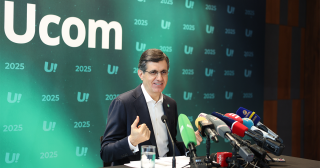
‘Music for Moderns: The Partnership of George Avakian and Anahid Ajemian’ Review

The central image of the exhibition in New York “Music for Moderns: The Partnership of George Avakian and Anahid Ajemian” shows the young couple traveling somewhere in Europe in 1949, standing next to both a train and an automobile. Somehow that seems like a perfect metaphor for the Avakians: He is one of the greatest record producers in the history of jazz, while she was a concert violinist and a leading figure in the world of contemporary classical music. A locomotive and a car are inherently different kinds of vehicles, but they both can transport you from one place to another and, ultimately, get you to where you’re going, the Wall Street Journal reported.
“Music for Moderns,” at the New York Public Library for the Performing Arts through Sept. 24, is an exhibit of personal photographs, album covers, contracts, vintage news releases, concert programs and other items from the couple’s papers. The exhibition is dedicated to Ms, Ajemian, who died on June 13, a few weeks before it was scheduled to open.
The most striking feature of the show is an impressive sequence of larger-than-life reproductions of classic albums produced by Mr. Avakian that line the upper walls of the Astor Gallery—from his pioneering 78 rpm collections (he is generally credited as having produced the very first jazz albums), starting in 1940, to his heyday as the head of multiple divisions at Columbia Records in the 1950s and later work with such notable jazz postmodernists as Charles Lloyd and Keith Jarrett.
Mr. Avakian has an impressive track record in producing what are widely regarded, in many cases, as the greatest works by the major names in jazz, such as “Ellington at Newport,” “Louis Armstrong Plays W.C. Handy” and Miles Davis’s “Miles Ahead,” as well as two of the most celebrated live albums ever, Benny Goodman’s classic 1938 Carnegie Hall Concert (which gave us the essential version of “Sing, Sing, Sing”) and Erroll Garner’s “Concert by the Sea.”
The exhibition is organized largely around Mr. Avakian’s relationships with these jazz giants, starting with a 1936 interview he did with Goodman for his high-school newspaper, the Horace Mann Record. Then there are sections devoted to his work with Goodman, Armstrong (including Satchmo’s original lyric sheet to “Mack the Knife,” a hit single produced by Mr. Avakian), Duke Ellington, Miles Davis, Dave Brubeck, Sonny Rollins and others.
There are also photographs and materials relating to his personal life, from his early days in Armavir (then part of Armenia, now part of Russia), where he was born in 1919, to his World War II service and his marriage to Ms. Ajemian in 1948. She had been born in Manhattan to Armenian immigrant parents in 1924 and was already famous as part of a duo with her sister, Maro, a concert pianist.
Anahid was an indefatigable supporter of new composers, such as the avant-gardists John Cage and Henry Cowell, and, most successfully, the Armenian-Scottish-American composer Alan Hovhaness, whose work was more straightfowardly melodic but no less strikingly original. It was Hovhaness, the exhibition reveals, who introduced Mr. Avakian—then head of world music at Columbia—to the Hindustani virtuoso Ravi Shankar, whom Mr. Avakian summarily recorded for Columbia (and whom the label photographed posing on a rug borrowed from Mr. Avakian’s father, a carpet merchant).
Possibly the most rewarding section of the show is a series of concert programs and photos devoted to the Avakians’ most successful work together professionally, a 1957 concert series at Town Hall that combined jazz and classical music—Duke Ellington (premiering his “Such Sweet Thunder”) alongside Dimitri Mitropoulos and the Ajemian sisters. Like the primary photo, which is also on the cover of the brochure devoted to the exhibit, those concerts are symbolic of a remarkable couple who, though they may have dwelled in different areas of music, traveled together to reach the same destination.
In the photo: Anahid Ajemian and George Avakian in Europe in 1949
By Will Friedwald























